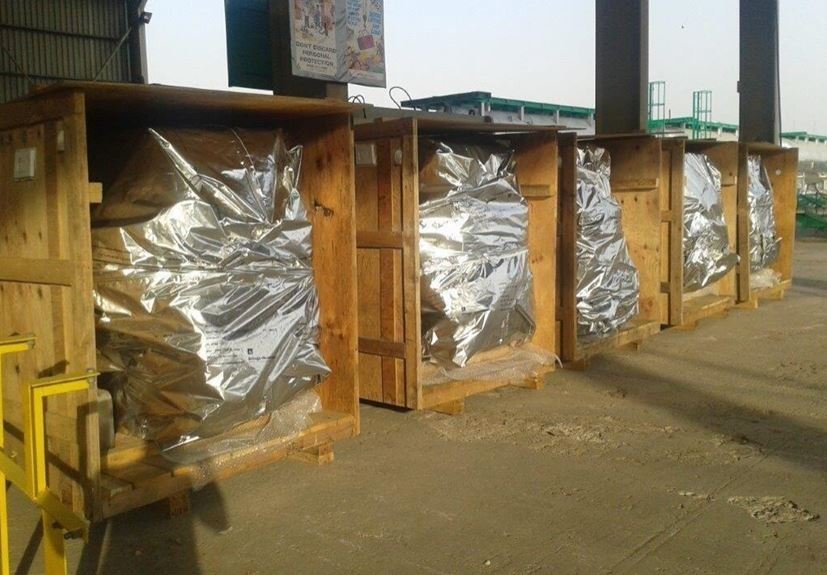The packaging of a product ensures the protection of the product during transit and also extends the shelf life of the product. The presence of atmospheric oxygen causes the growth of bacteria, fungi, or mold that can reduce the shelf life of the product. Vacuum packing is a method of packaging that removes oxygen from the package before sealing. Oxygen can be removed either manually or automatically after placing the products in a plastic film package and sealing the package. Vacuum packing is also used to prevent the evaporation of volatile components and with the flexible package, forms to reduce the volume of the contents and package like clothing or bedding.
Vacuum packaging can be used on a variety of products, often used in commercial and residential applications to preserve food. It is considered as a form of modified atmosphere packaging (MAP). This form of packaging ensures that the atmosphere around the product is altered from the external atmosphere to prevent product degradation.
Items Needed for Vacuum Packing
Choosing the correct vacuum machine for your needs is crucial and depending on the production levels, the product sizes, vacuum sealers can vary in price. The option of using a gas flush that injects an inert gas into the sealed package to help increase shelf life would also affect the final cost of the vacuum sealer required.
After narrowing down on the proper vacuum sealer, vacuum bags need to be chosen as determining the right vacuum bag for each product will help to ensure smooth and professional packaging of the product. Depending on the vacuum machine chosen, external compressors are often required for many commercial-grade sealers. For gas flush systems, external gas tanks will also be required.
Pros of Using Vacuum Packaging
-
Extended Shelf Life
Increasing the product shelf life depends on maintaining the ideal atmosphere depending on the product within the packaging. This can be achieved by using an inert gas or reducing the level of oxygen within the packing. Vacuum packing is one of the preferred modes of packing for many products that require long-term freezer storage. Vacuum sealing products can extend their shelf life by around three to five times, depending on what product is being stored and how.
Vacuum packaging helps to prolong the life of a variety of foods like meat, fish, vegetables, fruits, processed food, and more. These foods can be stored for an extended period and can be easily transported over long distances with minimal risk of food spoilage.
-
Protection from Freezer Burn
Freezer burn occurs when frozen food is exposed to air and has been damaged by dehydration and oxidation. Vacuum sealing protects products from freezer burn and dehydration as it keeps the air from coming in contact with the product. Freezer burn destroys the taste and texture of the food.
-
Effective Sealed Barrier
Vacuum bags with the proper sealing can protect products from dust, moisture, insects, and a variety of other external elements. With the most common vacuum bag used having a thickness of 3 mil thickness and with some bags going up to a 6-8 mil thickness, it is an excellent barrier of protection for most products.
-
Seals in Flavours
A vacuum-sealed product is not exposed to external elements and also prevents leakage of flavors from the sealed bag. This ensures that the flavor, texture, and inner moisture are perfectly preserved resulting in lasting freshness. The nutritional value of food products is also preserved and cross-contamination is avoided.
-
Absence of Chemical Preservatives
Vacuum packaging eliminates the usage of chemical preservatives. With the right mixture of oxygen to inert gas, products can last longer without the use of commonly used preservatives.
-
Improved Product Presentation
Most vacuum bags are transparent, allowing easy visibility of the product within ensuring the consumer can examine the product, assess its condition before purchasing. Vacuum packaging not only retains the product’s quality but also helps to improve product presentation.
-
Super Compactness
The pressure used to vacuum products helps to decrease the volume of clothing or bed linen several times, significantly saving space used during transit and storage. This method reduces the volume, protects the materials from dust, moisture and mites. It saves space as compared to the packaging of products in rigid containers.
Cons of Using Vacuum Packaging
-
ExpensiveMachinery
Good quality vacuum sealers are expensive and the bags are often single-use or semi-reusable. Vacuum packaging also generates large amounts of plastic that is not easily recyclable.
-
Unreliable Protection
Vacuum packaging comes in many different shapes like special bags, sacks, and foils, but also jars and cans made of glass, plastic, or stainless steel. Any puncture to the packaging would expose the product to oxygen thus ruining the efficiency of the vacuum packing.
-
Improper Handling Hampers The Taste of The Product
A vacuum sealed product needs to be handled properly to eliminate spoilage. Frozen vacuumed food products need to be stored at the required temperature in the freezer and thawed properly to minimize bacteria growth. Vacuum packing does not automatically make food safe and proper measures need to be followed to maintain food safety.
-
Presence of Anaerobic Bacteria
Vacuum packaging especially of food products needs to be stored at the right temperature, humidity, and for the right time. If not maintained properly, dangerous anaerobic microorganisms can multiply in the food. There are types of bacteria that prefer low oxygen environments and grow well in vacuum packed foods. This type of bacteria produces a toxin that causes food poisoning, paralysis, and even death.
-
Delicate FoodItems Cannot be Vacuum Packed
Soft and spongy food items like bread, cakes, leafy vegetables cannot withstand being vacuum sealed. The vacuum bag compresses and crushes them thus ruining their texture and shape. It also causes bruising in leafy vegetables that leads to the decomposition of the same at a faster rate.
Despite the mentioned cons, vacuum packing is one of the best ways to prolong the shelf life of products especially food items.





